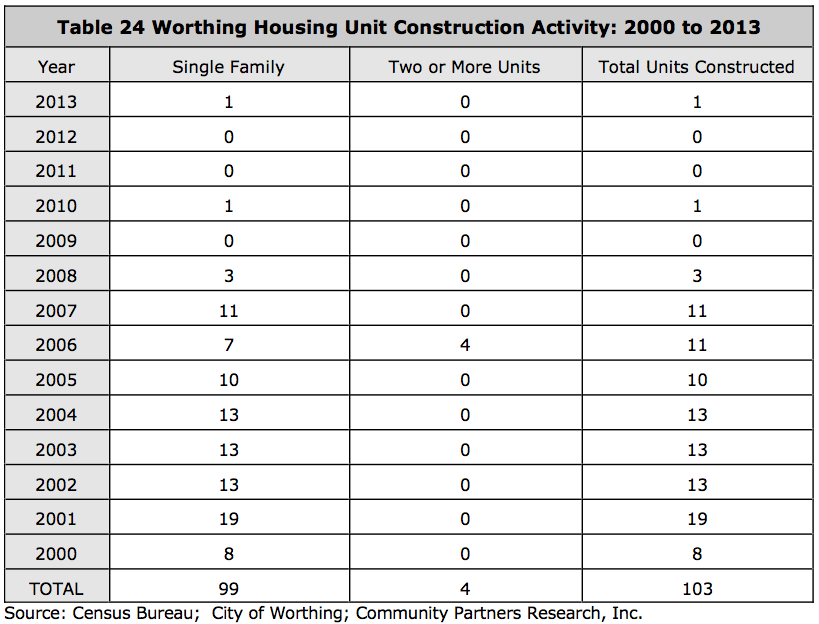A Facebook friend points out that Worthing has published its new housing study. I can't help replying, "Worthing has houses?"
Heck yeah, more than 300! Twenty of them sold last year for a median price of $130K; none sold for more than $150K.Worthing has benefited from its location ten miles south of Sioux Falls in picking up population. In the 1990s, the number of Worthing households grew by 61%, the same as surrounding Lincoln County. But in the next decade, Worthing's household increase fell back just a bit, to 58%. A lot of towns the size of Worthing (their total population is 958, projected to add another 172 over the next five years) would envy that growth rate. But in the 2000s, Lincoln County as a whole added households at a rate of 90%. Why didn't Worthing keep up?Perhaps Worthing is the poster child for the impacts of cheap gasoline and the housing bubble in South Dakota. Check out new housing construction from 2000 to 2013: Pre-recession, Worthing regularly saw more than 10 new housing units a year. Then when we started seeing 3s leading the price signs at Cenex, Worthing's housing starts dropped off a cliff. In the last six years, Worthing has issued five new housing construction permits. Ouch.Community Partners Research recommends that Worthing "be realistic" and not expect large-scale residential growth... but I'm feeling optimistic this morning. Worthing, I say nuts to that. Go to marketing war. Remind people that you are closer to I-90 and Sioux Falls than Lennox, and probably prettier (I don't know how you quantify that, but hey! If I may plagiarize Susan Wismer, this isn't academia; it's marketing!). Put some of your higher than average income (median household income 32% higher than state median) to work fixing up houses—the report says more than a quarter of your core-area houses are in need of major repair.The report encourages Worthing to consider a number of incentive programs, like low-interest loans, tax breaks, and lower fees for utility hookups, and probably some other public action that will prompt Sibby to co-opt the conversation and holler about public-private partnerships and government interference in the marketplace. But I have to wonder: did the 2008 recession and the normalization of three- to four-dollar gasoline mark a hard reset from which certain bedroom communities at a certain distance from urban hubs will not recover? If there is a permanent shift away from sprawl and long commutes, perhaps Worthing's growth strategy will have to focus just as much on building local businesses as it does on housing.
Pre-recession, Worthing regularly saw more than 10 new housing units a year. Then when we started seeing 3s leading the price signs at Cenex, Worthing's housing starts dropped off a cliff. In the last six years, Worthing has issued five new housing construction permits. Ouch.Community Partners Research recommends that Worthing "be realistic" and not expect large-scale residential growth... but I'm feeling optimistic this morning. Worthing, I say nuts to that. Go to marketing war. Remind people that you are closer to I-90 and Sioux Falls than Lennox, and probably prettier (I don't know how you quantify that, but hey! If I may plagiarize Susan Wismer, this isn't academia; it's marketing!). Put some of your higher than average income (median household income 32% higher than state median) to work fixing up houses—the report says more than a quarter of your core-area houses are in need of major repair.The report encourages Worthing to consider a number of incentive programs, like low-interest loans, tax breaks, and lower fees for utility hookups, and probably some other public action that will prompt Sibby to co-opt the conversation and holler about public-private partnerships and government interference in the marketplace. But I have to wonder: did the 2008 recession and the normalization of three- to four-dollar gasoline mark a hard reset from which certain bedroom communities at a certain distance from urban hubs will not recover? If there is a permanent shift away from sprawl and long commutes, perhaps Worthing's growth strategy will have to focus just as much on building local businesses as it does on housing.

If memory serves, Worthing has the challenge of significant aging infrastructure, especially water & sewer lines. The "old" part of Worthing needed serious upgrades in order to allow much more new housing developments to connect. It's been a while since I was in Worthing, but if they're still struggling with that, it would explain why nobody is carving up a section of land for development.
Good insight Wayne. Infrastructure first, housing second.
Are there commuter buses running from the bedroom communities to Sioux Falls? A easy to use and reliable mass transit system would help SF businesses recruit workers and relieve problems with parking in SF.